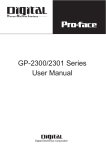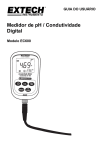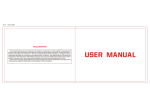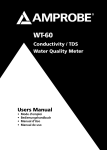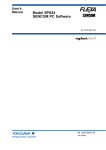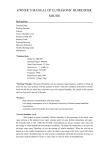Download User manual - XS Instruments
Transcript
70 Series pH/Conductivity Portable Meter Manual PH 70 Portable pH Meter COND 70 Portable Cond. Meter PC 70 Portable pH/Cond. Meter PC70 Version1.4 Table of Contents 1. Introduction --------------------------------------------------------------------------------------------------------------------------1 2. Specifications ------------------------------------------------------------------------------------------------------------------------2 3. Instrument Description ------------------------------------------------------------------------------------------------------------3 3.1. LCD display---------------------------------------------------------------------------------------------------------------------3 3.2. Keypad functions --------------------------------------------------------------------------------------------------------------4 3.3. Meter socket ---------------------------------------------------------------------------------------------------------------------6 3.4. Reading stability display mode-----------------------------------------------------------------------------------------------6 3.5. Store, recall and clear readings--------------------------------------------------------------------------------------------6 3.6. Auto. power off ---------------------------------------------------------------------------------------------------------------7 4. pH measurement -------------------------------------------------------------------------------------------------------------------7 4.1. pH electrode information-----------------------------------------------------------------------------------------------------7 4.2. pH calibration consideration ------------------------------------------------------------------------------------------------7 4.3. pH calibration -------------------------------------------------------------------------------------------------------------------9 4.4. Customer-defined calibration ------------------------------------------------------------------------------------------------9 4.5. Sample test ----------------------------------------------------------------------------------------------------------------------10 4.6. pH electrode maintenance---------------------------------------------------------------------------------------------------12 5. mV measurement--------------------------------------------------------------------------------------------------------------------13 6. Conductivity measurement ---------------------------------------------------------------------------------------------------------13 6.1. Conductivity electrode information------------------------------------------------------------------------------------------13 6.2. Conductivity calibration consideration------------------------------------------------------------------------------------14 6.3. Conductivity calibration-------------------------------------------------------------------------------------------------------16 6.4. Relations between TDS and conductivity--------------------------------------------------------------------------------16 6.5. Customer-defined calibration-------------------------------------------------------------------------------------------------17 6.6. Sample test-----------------------------------------------------------------------------------------------------------------------17 6.7 Conductivity electrode maintenance----------------------------------------------------------------------------------------18 7. Parameter setting---------------------------------------------------------------------------------------------------------------------18 7.1. Main menu------------------------------------------------------------------------------------------------------------------------18 7.2. Submenu -------------------------------------------------------------------------------------------------------------------------18 7.3. Submenu of pH parameter setting ------------------------------------------------------------------------------------------20 7.4. Conductivity parameter setting submenu--------------------------------------------------------------------------------21 7.5. Submenu of TDS parameter setting --------------------------------------------------------------------------------------22 7.6. Submenu of basic parameter setting ---------------------------------------------------------------------------------------23 8. USB communication------------------------------------------------------------------------------------------------------------------24 9. Meter Kits--------------------------------------------------------------------------------------------------------------------------------26 10. Warranty-------------------------------------------------------------------------------------------------------------------------------26 Appendix I: Parameter setting and factory restoring setting------------------------------------------------------------------27 Appendix II: Abbreviation Glossary--------------------------------------------------------------------------------------------------28 Appendix III: Self-diagnosis information--------------------------------------------------------------------------------------------29 PC70 Version1.4 1. Introduction Thanks for purchasing 70 series portable pH/Conductivity meter. This meter is perfect combination of the most advanced electronics, sensor technology and software design, and is the most cost effective portable electrochemical meter suited for industrial and mining enterprises, power plant, water treatment engineering, environmental protection industry, etc, especially suited for application in field. In order to use and maintain the instrument properly, please read the manual thoroughly before use. To improve instrument performance constantly, we reserve the right to change the manual and accessories without giving notice in advance. 1.1. Measurement parameters Measurement parameters pH70 pH/mV √ COND70 √ Conductivity/TDS Temperature PC70 √ √ √ √ √ 1.2. Basic features ● The microprocessor-based portable meter features automatic calibration, automatic temperature compensation, function set-up, self-diagnostics, due calibration reminding, calibration date checking, automatic power-off and low voltage display. ● Meet GLP, clock display, manual storage and automatic timing storage, USB port. ● The meter’s digital filter improves measurement speed and accuracy. There is reading stability display. ● The package includes portable case, meter, electrode, standard solutions and all accessories, convenient to use in field. ● The meter is dust-proof and water-proof, meeting the IP57 rating. ● Temperature calibration function. 1.3. pH measurement features (suited for model PH70 and PC70) ● 1-3 point automatic calibration, the meter provides calibration guide and automatic checking function. ● The meter is able to recognize up to 8 types of pH standard buffer solutions. There are three options of standard buffer solution: USA series, NIST series and customer-defined solution set-up. ● The meter provides reading stability criteria. 1.4. Conductivity measurement features (suited for model COND70 and PC70) ● 1-4 point automatic calibration, the meter provides calibration guide and automatic checking function. ● The meter is able to switch among conductivity, TDS and salinity measurement mode. 1 PC70 Version1.4 ● The meter is able to switch between conductivity and TDS measurement mode. ● The meter is able to recognize up to 4 types of conductivity standard solutions. There is customer-defined solution set-up. 2. Specifications 2.1. Main specifications Specifications Range (-2.00 ~ 16.00)pH Resolution 0.1/0.01 pH Accuracy ±0.01 pH ±1digit Temperature compensation Multi-point calibration pH mV Models (0 ~ 100)°C(manual or automatic) 1-3 point PH 70 PC 70 Buffer value USA: 1,68-4,00-7,00-10,01pH NIST: 1,68-4,01-6,86-9,18pH 2 value CUSTOMER Range ±1,999mV Resolution ±200 mV :0.1 mV ;others:1mV Accuracy ±0.1% FS ±1digit Conductivity:0~200 mS/cm,divided into five ranges: (0.00~19.99)μS/cm (20.0~199.9)μS/cm Range (200~1999)μS/cm (2.00~19.99)mS/cm (20.0~199.9)mS/cm TDS:(0 ~ 100)g/L, Salinity: (0 – 100) ppt Resolution Conductivity Temperature 0.01/0.1/1μS/cm 0.01/0.1 mS/cm C0ND 70 Accuracy ±1.0% FS ±1digit Temperature compensation (0 ~ 100)°C(manual or automatic) Multi-point calibration 1-4 point Standard solution 84 μS/cm, 1413 μS/cm, 12.88, 111,9 mS/cm 1 customer value Electrode constant 0.1 / 1 / 10 cm-1 Range -10~110°C Resolution 0.1℃ Accuracy ±0.5℃±1digit PC 70 PH 70 C0ND 70 PC 70 Reading stability criteria Low:1.2mV/10 sec., Medium:0.6mV/10 sec., High:0.3mV/10 seconds PH 70 PC 70 Due calibration Remind due calibration PH 70 PC 70 2 PC70 Version1.4 Out of test PH 70 PC 70 Electrode provides error 2.2. Other specifications: Data storage 500 groups Storage content Serial number, date, time, measuring value, measuring unit and temperature value Output USB Power AAA batteries × 3 (1.5V× 3) / 220 V with USB power supply IP rating IP57 Dimension & Weight Meter: (86×196×33 )mm / 335g 3. Instrument description 3.1. LCD display: Diagram-1 (1) — Parameter mode icons (2) — Measurement reading (3) — Timing storage icon. When this icon appears, the meter is in the automatic storage mode (4) — Time(appears with (5), and prompts of special display mode (5) — Date(appears with (4)) (6) — Units of measurement (7) — Temperature units (°C and °F) (8) — Units of pH and conductivity calibration value(appears with(9)) (9) — pH and conductivity calibration value(appears with (8)), the serial number for storage and recall (appears with (10)), and prompts of special display mode (10) — Storage and recall icons M+ — Measurement to be stored icon, RM — Reading to be recalled icon 3 PC70 Version1.4 (11) — Temperature value(appears with (7)), and prompts of special display mode (12) — Temperature compensation icons ATC — automatic temperature compensation, MTC — manual temperature compensation (13) — Calibration guide icon (14) — USB icon,when this icon appears, the meter connects the computer (15) — Stability icon of readings (16) —Low battery icon, when this icon appears, please renew the battery 3.2. Keypad functions Diagram-2 3.2.1. Keypad operations Momentary press ----- <1.5 seconds , Long press ----- >1.5 seconds. 3.2.2. Turn on the meter Press to turn on the meter: LCD full display → display some parameters → display the last measurement mode (backlight for one minute). 3.2.3. Turn off the meter In the measurement mode, press and hold for 2 seconds to turn off the meter. Note: In the calibration mode or the parameter set-up mode, pressing is invalid. Please press CAL/MEAS key to return to the measurement mode, then press to turn off the meter. 4 PC70 Version1.4 Chart – 1 Keypad operations and descriptions Keypad Operations Descriptions Momentary press ● In the power-off mode, press this key to turn on the meter ● In the measurement mode, press this key to turn on or turn off the backlight display. Long press ● In the measurement mode, press and hold this key for 2 seconds to turn off the meter. Momentary press Measurement mode: ● PH70 pH meter: pH → mV, ● COND70 Conductivity meter: COND → TDS → SAL , ● PC70 pH/Conductivity meter: pH → mV → COND → TDS → SAL Momentary press ● In the measurement mode, press this key to enter in the calibration mode ● In the calibration mode or the parameter set-up mode, press this key to return to the measurement mode Momentary press ● In the measurement mode, press this key to enter in the parameter set-up main menu ● In the calibration mode, press this key to make calibration ● In the parameter set-up mode, press this key to select programs Momentary/ long press ● In the mode of manual temperature compensation (MTC), when press and hold this key, the temperature value flashes, then press this key to change the temperature value, and press to confirm ● In the measurement mode, press this key to store the measuring value. ● In the recall mode (RM), press momentarily this key to change the storage serial number, press and hold this key to change the number quickly ● In the parameter set-up mode, press this key to change the serial number of the main menu and the submenu ● In the submenu mode, press this key to change parameters and set-up Momentary/ long press ● In the mode of manual temperature compensation (MTC), when press and hold this key, the temperature value flashes, then press this key to change the temperature value, and press to confirm ● In the measurement mode, press this key to recall the stored measuring value. ● In the recall mode (RM), press momentarily this key to change the storage serial number, press and hold this key to change the number quickly ● In the parameter set-up mode, press this key to change the serial number of the main menu and the submenu ● In the submenu mode, press this key to change parameters and set-up 5 PC70 Version1.4 3.3. Meter socket Electrode socket uses BNC and RCA. USB socket uses standard type. The following chart is socket for model PH70, COND70 and PC70: Chart – 2 Sockets for meters Models Photos Description PH70 pH meter •BNC socket (right) — connect pH electrode or ORP electrode, • RCA socket (middle) — connect temperature probe COND70 Conductivity meter •BNC socket (left) — connect conductivity electrode, • RCA socket (middle) — connect temperature probe PC70 pH/Conductivity meter •BNC socket (right) — connect pH electrode or ORP electrode, •BNC socket(left) — connect conductivity electrode, • RCA socket (middle) — connect temperature probe 3.4. Reading stability display mode When the measuring value is stable, smiley icon appears on LCD, see Diagram – 3. If the icon does not appear or flash, please do not get the reading value or make calibration until the measuring value is stable. Per parameter P1.6, there are 3 criteria for stability standard: (Normal), (High) and (Low). The factory default is set “Normal”. “High” is set for stability for longer time, “Low” is set for stability for shorter time. User can select suitable stability criteria according to different testing requirement. 3.5. Store, recall and clear readings 3.5.1. Manual storage When the measurement is stable, press momentarily Diagram - 3 key, M+ icon and storage serial number appear on LCD, storing measuring information, see Diagram – 4. 3.5.2. Automatic timing storage Set the storage timing (eg. 3 minutes) per parameter P6.3, icon appears on LCD and the meter enters into the timing storage mode. When press momentarily key, key flashes and the first measuring value is stored. After 3 minutes, the 2nd measuring value is stored. See Diagram – 5: the meter stores automatically eight measuring values. When press momentarily key, icon stops flashing and the meter stops automatic storage. In automatic storage mode, manual storage does not work. Set time 0 per parameter P6.3 to exit from the automatic storage mode. 6 Diagram - 4 Diagram - 5 PC70 Version1.4 3.5.3. Recall stored value In the measurement mode, press key to recall the last stored measuring value. See Diagram – 6: display RM icon and storage serial number. Continue pressing key and key to recall successively the stored measuring value. Press and hold key and key to recall quickly the stored measuring value. Diagram - 6 3.5.4. Clear stored value Select YES per parameter P6.7 to clear all stored value, refer to clause 7.6. 3.6. Automatic power-off The meter will be power-off after the meter stops operation for 20 minutes. During Auto Logging Automatic power-off disable. 4. pH measurement 4.1. pH electrode information The meter matches 201T-F plastic three-in-on combination pH electrode with built-in temperature sensor to realize automatic temperature compensation. Electrode housing adopts polycarbonate engineering plastics which is corrosion and impact resistant. The BNC socket of electrode connects pH socket, RCA socket connects temperature socket. When dip the electrode in the solution, please stir the solution briefly and allow it to stay in the solution until a stable reading is reached. 4.2. pH calibration consideration 4.2.1. Standard buffer solution The meter uses two series of standard buffer solution: USA series and NIST series, and also customer-defined solution. Please see Chart - 3 for the two series of standard buffer solution. For customer-defined solution, please select it per parameter P1.1 and refer to clause 7.3 for details. Chart - 3 pH standard buffer solution series Icons pH standard buffer solution series USA Series NIST series 1.68 pH and 4.00 pH 1.68 pH and 4.01 pH 7.00 pH 6.86pH 10.01 pH 9.18 pH Three-point calibration 4.2.2. Three-point calibration The instrument can perform 1-3 point calibration. The first point calibration must use 7.00 pH (or 6.86 pH) standard solution, then select other standard solution to perform the second and the third point calibration, see Chart-4. During the calibration process, the instrument displays the electrode slope of acidity range and alkalinity range respectively. 7 PC70 Version1.4 Chart - 4 Three-point calibration mode USA standard NIST standard 7.00 pH 6.86 pH Accuracy ≤ ±0.1pH 7.00 pH, 4.00 pH or 1.68 pH 6.86 pH, 4.01 pH or 1.68 pH Range<7.00pH 7.00 pH and 10.01pH 6.86 pH and 9.18pH Range>7.00pH One-point calibration Two-point calibration Three-point calibration 7.00 pH, 4.00 pH or 1.68 pH, 10.01 pH Icons Suited range 6.86 pH, 4.01 pH or 1.68 pH, 9.18 pH Large Range 4.2.3. Calibration intervals Calibration intervals depend on the sample, the electrode performance, and the required accuracy. For high accuracy measurements (≤ ±0.02pH), the meter should be calibrated immediately before taking a measurement. For general accuracy (≥±0.1pH), the meter can be calibrated and used for approximately one week before the next calibration. The meter must be recalibrated in the following situations: (a) New probe, or probe that is unused for a long period of time (b) After measuring acids (pH<2) or alkaline solutions (pH>12) (c) After measuring a solution that contains fluoride or a concentrated organic solution (d) If the solution’s temperature differs greatly from the calibration solution temperature 4.2.4. Due calibration Pre-set calibration interval (begin from the date of last calibration) to remind due calibration in a preset period per parameter P1.2 (clause 7.3). During due calibration, Er 7 icon appears on LCD (see Diagram – 7). The meter can not continue operation and Er 7 icon disappears until the calibration is done, or when select No per parameter P1.2. Diagram - 7 4.2.5. Check calibration date Check the date and time of last calibration to decide whether new calibration is needed. Please refer to parameter setting P1.3 (clause 7.3). 8 PC70 Version1.4 4.3. pH calibration ( take an example of three-point calibration) 4.3.1. Press key to enter into the calibration mode, “CAL 1” blinks at the top right of LCD and “7.00 pH ”blinks at the bottom right of LCD, indicating using pH 7.00 buffer solution to make the 1st point calibration. 4.3.2. Rinse pH electrode in pure water, allow it to dry, and submerge it in pH7.00 buffer solution. Stir the solution briefly and allow it to stay in the buffer solution until a stable reading is reached. The meter’s display will show scanning and locking process of calibration buffer solution at the bottom right of LCD. Er 2 displays if press is locked. See Chart – 5. 4.3.3. When the meter locks 7.00 pH, stable key before the value icon displays on LCD. Press key to calibrate the meter. End icon appears after calibration is done. The 1st point calibration is finished, meanwhile, the meter’s display will show at the top right a blinking CAL2, and show at the bottom right blinking 4.00pH and 10.01pH alternately, indicating using pH4.00 or pH10.01 buffer solution to make the 2nd point calibration. 4.3.4. Take out pH electrode,rinse it in pure water, allow it to dry, and submerge it in pH4.00 buffer solution. Stir the solution briefly and allow it to stay in the buffer solution until a stable reading is reached. The meter’s display will show scanning and locking process of calibration buffer solution at the bottom right of LCD. When the meter locks 4.00 pH, stable icon displays on LCD. Press key to calibrate the meter. End icon and electrode slope of acidity range display after calibration is done, meanwhile, the meter’s display will show at the top right a blinking CAL3, and show at the bottom right blinking 10.01pH, indicating using pH10.01 buffer solution to make the 3rd point calibration. 4.3.5. Take out pH electrode,rinse it in pure water, allow it to dry, and submerge it in pH10.01 buffer solution. Stir the solution briefly and allow it to stay in the buffer solution until a stable reading is reached. The meter’s Diagram - 8 display will show scanning and locking process of calibration buffer solution at the bottom right of LCD. When the meter locks 10.01 pH, stable icon displays on LCD. Press key to calibrate the meter. End icon and electrode slope of alkalinity range display after calibration is done. The meter goes to the measurement mode, displays stable measuring value and calibration guide icons.Please see Diagram – 8 for the above calibration process. 4.3.6. During the calibration process, press key to exit from the calibration mode. The meter can perform one-point, two-point and three-point calibration. Calibration guide icons appear on LCD. 4.4. Customer-defined calibration (take an example of 1.60pH and 6.50pH calibration solution) 4.4.1. Select CUS per parameter P1.1 (please refer to clause 7.3 for customer-defined solution). The meter enters into Customer-defined calibration mode. Press key, the meter’s display show a blinking CAL1 icon at the top right of LCD, indicating the meter enters into the 1st point customer-defined 9 PC70 Version1.4 calibration. 4.4.2. Rinse pH electrode in pure water, allow it to dry, and submerge it in pH1.60 buffer solution. Stir the solution briefly and allow it to stay in the buffer solution until a stable reading is reached. For automatic temperature compensation (ATC), the temperature value does not blink. When press key, the main value blinks. Press key or key to adjust the main value to 1.60, then press key to calibrate the meter. After calibration is done, LCD at the top right shows blinking CAL2 icon, indicating the meter enters into the 2nd point customer-defined calibration. Note: For manual temperature compensation (MTC), when LCD displays the stable measuring value and icon, press key, then the temperature value blinks, Press key or key to adjust the temperature value, and press key to confirm it. Then the main value blinks. Follow the above procedures to adjust the main value and calibrate the meter. 4.4.3. Rinse pH electrode in pure water, allow it to dry, and submerge it in pH 6.50 buffer solution. Stir the solution briefly and allow it to stay in the buffer solution until a stable reading is reached. For automatic temperature compensation (ATC), the temperature value does not blink. When press key, the main value blinks. Press key or key to adjust the main value to 6.50, then press key to calibrate the meter. After calibration is done, the meter goes to the measurement mode. For customer-defined calibration, LCD does not show electrode calibration guide icons. Note: For manual temperature compensation (MTC), when LCD displays the stable measuring value and smiley icon, press key and the temperature value blinks. Press key or key to adjust the temperature value, and press to confirm it. Then the main value blinks. Follow the above procedures to adjust the main value and calibrate the meter. 4.4.4. Notes (a) The meter can perform 1-2 point customer-defined calibration. When the 1st point calibration is done, press key, the meter exits from calibration mode. This is one-point customer-defined calibration. (b) The value set in “Customer-defined” is at a fixed temperature. The meter has to perform calibration and measurement at the same temperature to avoid large error. The meter cannot recognize customer-defined calibration solution. 4.5. Sample test 4.5.1. Rinse pH electrode in pure water, allow it to dry, and submerge it in tested solution. Stir the solution briefly and allow it to stay in the tested solution until icon appears on LCD and a stable reading is reached which is pH value of tested solution. 10 PC70 Version1.4 Diagram – 9 is the calibration and measurement process of pH meter Press to turn on the meter. Press key to enter into the calibration mode. Submerge the electrode in pH7.00 solution, press key when icon appears. Submerge the electrode in pH4.00 solution, press key when icon appears. Submerge the electrode in pH10.01solution,press key when icon appears. After the 1st point st calibration is done, 1 point calibration press key to enter into the measurement mode. After the 2nd point calibration is done, press key to enter into the measurement mode. After the 3rd point calibration is done, the meter enters into the measurement mode automatically. 2nd point calibration Sample Test 3r dpoint calibration Diagram – 9 Calibration and measurement process of pH meter 4.5.2. Self-diagnosis information During the process of calibration and measurement, the meter has self-diagnosis functions, indicating the relative information as below, please refer to Chart – 5. Chart – 5 Self-diagnosis information of pH measurement mode Display Icons Contents Checking Wrong pH buffer solution or the meter recognition of calibration solution out of range 1.Check whether pH buffer solution is correct. 2.Check whether the meter connects the electrode well. 3.Check whether the electrode is damaged. Press key when measuring value is not stable during calibration. Press During calibration, the measuring value is not stable for ≥3min. 1.Check whether there are bubbles in glass bulb. 2.Replace with new pH electrode. Electrode zero electric potential out of range (<-60mV or >60mV) Electrode slope out of range(<85% or >110%) key when icon appears 1.Check whether there are bubbles in glass bulb. 2.Check whether pH buffer solution is correct. 3.Replace with new pH electrode. pH measuring range out of range(<-2.00 pH or >16.00pH) 1.Check whether the electrode is suspended. 2.Check whether the meter connects the electrode well. 3.Check whether the electrode is damaged Enter in pre-set due calibration to remind due calibration Press key to perform calibration or cancel due calibration setup per parameter P1.2 11 PC70 Version1.4 4.5.3. pH temperature principle Note that the closer the temperature of the sample solution to the calibration solution, the more accurate readings 4.5.4. Factory default setting For factory default setting, please refer to parameter P1.5 (clause 7.3). Per parameter P1.5, all calibration data is deleted and the meter restores to the theory value (zero electric potential of pH is 7.00, the slope is 100%). Some functions restore to the original value (refer to appendix -1). When calibration or measurement fails, please restore the meter to factory default setting and then perform re-calibration or measurement. Please note once set the factory default, all the data deleted will not be retrievable. 4.6. pH electrode maintenance 4.6.1. Daily maintenance The soaking solution contained in the supplied protective bottle is used to maintain activation in the glass bulb and junction. Loosen the capsule, remove the electrode and rinse in pure water before taking a measurement. Insert the electrode and tighten the capsule after measurements to prevent the solution from leaking. If the soak solution is turbid or moldy, replace the solution. The electrode should not be soaked in pure water, protein solution or acid fluoride solution for long periods of time. In addition, do not soak the electrode in organic silicon lipids. For best accuracy, always keep the meter clean and dry, especially the meter’s electrode and electrode jack. Clean with medical cotton and alcohol if necessary. 4.6.2. Calibration buffer solution For calibration accuracy, the pH of the standard buffer solution must be reliable. The buffer solution should be refreshed often, especially after heavy use. 4.6.3. Protect glass bulb The sensitive glass bulb at the front of the combination electrode should not come in contact with hard surfaces. Scratches or cracks on the electrode will cause inaccurate readings. Before and after each measurement, the electrode should be washed with pure water and dried. Do not clean the glass bulb with a tissue for it will affect the stability of the electrode potential and increase the response time. The electrode should be thoroughly cleaned if a sample sticks to the electrode. Use a solvent if the solution does not appear clean after washing. 4.6.4. Renew glass bulb Electrodes that have been used over a long period of time, will become ageing. Submerge the electrode in 0.1mol/L hydrochloric acid for 24 hours, then wash the electrode in pure water, then submerge it in soaking solution for 24 hours. The method to prepare 0.1mol/L hydrochloric acid: dilute 9mL hydrochloric acid in pure water to 1000mL. For serious passivation, submerge the bulb in 4% HF (hydrofluoric acid) for 3-5 seconds, and wash it in pure water, then submerge it in the soaking solution for 24 hours to renew it. 4.6.5. Clean contaminated glass bulb and junction (please refer to Chart – 6) 12 PC70 Version1.4 Chart – 6 Clean contaminated glass bulb and junction Contamination Abluent Inorganic metal oxide Dilute acid less than 1mol/L Organic lipid Dilute detergent (weak alkaline) Resin macromolecule Dilute alcohol, acetone, ether Proteinic haematocyte sediment Acidic enzymatic solution (saccharated yeast tablets) Paint Dilute bleacher, peroxide Note: The electrode housing is polycarbonate. When use abluent, take cautions on carbon tetrachloride, trichlorethylene, tetrahydrofuran, acetone, etc which will dissolve the housing and invalidate the electrode. 5. mV measurement: 5.1. Press key, and switch the meter to mV measurement mode. Connect ORP electrode (need purchase it separately) and dip it in sample solution, stir the solution briefly and allow it to stay in the solution until icon appears and get the reading which is ORP value. ORP means Oxidation Reduction Potential. The unit is mV. 5.2. Notes 5.2.1. ORP measurement does not require calibration. When the user is not sure about ORP electrode quality or measuring value, use ORP standard solution to test mV value and see whether ORP electrode or meter works properly. 5.2.2. Clean and activate ORP electrode After the electrode has been used over long period of time, the platinum surface will get polluted which causes inaccurate measurement and slow response. Please refer to the following methods to clean and activate ORP electrode: (a) For inorganic pollutant, submerge the electrode in 0.1mol/L dilute hydrochloric acid for 30 minutes, then wash it in pure water, then submerge it in the soaking solution for 6 hours. (b) For organic or lipid pollutant, clean the platinum surface with detergent, then wash it in pure water, then submerge it in the soaking solution for 6 hours. (c) For heavily polluted platinum surface on which there is oxidation film, polish the platinum surface with toothpaste, then wash it in pure water, then submerge it in the soaking solution for 6 hours. 6. Conductivity Measurement: 6.1. Conductivity electrode information 6.1.1. Conductivity electrode Model 2301T-F plastic conductivity electrode with constant K=1.0 and built-in temperature sensor, can realize automatic temperature compensation. The electrode housing is polycarbonate plastic which is corrosion resistant and impact resistant. BNC jack of electrode connects to the meter’s conductivity input jack, RCA jack connects temperature jack. When submerge the conductivity electrode in solution, stir the solution briefly to eliminate the air bubbles and improve response and stability. 13 PC70 Version1.4 6.1.2. Conductivity electrode constant The meter matches conductivity electrodes of three constants: K=0.1, K=1.0 and K=10.0. Please refer to chart-7 for measuring range. Set constant per parameter P2.1 and refer to clause 7.4. Chart –7 Electrode constant and measuring range Range <20 μS/cm 0.5μS/cm~100mS/cm >100mS/cm Conductivity electrode constant K=0.1 cm-1 K=1.0 cm-1 K=10 cm-1 Standard solution 84μS/cm 84μS/cm 1413 μS/cm 12.88 mS/cm 111.9 mS/cm 6.2. Conductivity calibration consideration 6.2.1. Conductivity calibration solutions The meter uses conductivity standard solution: 84μS/cm, 1413μS/cm, 12.88 mS/cm, 111.9 mS/cm and customer-defined solution. Select the standard solution per parameter P2.2 (refer to clause 7.4). The meter can recognize the standard solution automatically, can perform one-point or multi-point calibration (the maximum is four-point calibration). The calibration guide icons at the bottom left of LCD correspond to the four standard values. See chart – 8: Chart – 8 Conductivity standard solution series Calibration guide icons Calibration solution series Range 84 μS/cm 0-200 μS/cm 1413 μS/cm 200-2,000 μS/cm 12.88 mS/cm 2-20 mS/cm 111.9 mS/cm 20-200 mS/cm 6.2.2. Calibration intervals (a) The meter is calibrated before leaving the factory and can generally be used right out of the box. (b) Normally perform calibration per month. (c) For high accuracy measurements or large temperature deviation from the reference temperature (25°C), perform calibration per week. (d) Use conductivity standard solution to check whether there is error. Perform calibration for large error. (e) For new electrode or factory default setting, perform 3-point or 4-point calibration. Choose closer standard solution to the sample solution to perform 1- point or 2-point calibration. For example: 1413 μS/cm standard solution is suited for range 0-2,000 μS/cm. 14 PC70 Version1.4 6.2.3. One-point and multi-point calibration For 1-point calibration after 3-point or 4-point calibration, the previous calibration value in the same range will be replaced, meanwhile, the meter will show the calibration guide icon of this point, other two calibration guide icons will be deleted, but the chip will reserve the last calibration data. After the meter restores to factory default setting, all the calibration data is deleted and the meter restores to theory value. When choose multi-point calibration, perform calibration from low to high concentration to avoid standard solution of low concentration being contaminated. 6.2.4. Reference temperature Reference temperature of factory default is 25°C. Other reference temperature can also be set for range 15°C – 30°C. Select per parameter P2.5 and see clause 7.4. 6.2.5. Temperature coefficient The temperature compensation coefficient of the meter setting is 2.0%. However, the conductivity temperature coefficient is different for solutions of a different variety and concentration. Please refer to chart – 9 and the data collected during testing. Set per parameter P2.6. and see clause 7.4. Note: When the coefficient for the temperature compensation is set to 0.00 (no compensation), the measurment value will be based on the current temperature. Chart – 9 Temperature compensation coefficient of special solutions Solution Temperature compensation coefficient NaCl salt solution 2.12%/°C 5%NaOH solution 1.72%/°C Dilute ammonia solution 1.88%/°C 10% hydrochloric acid solution 1.32%/°C 5% sulfuric acid solution 0.96%/°C 6.2.7. Avoid contamination of standard solution Conductivity standard solution has no buffer. Please avoid being contaminated during usage. Submerge the electrode in standard solution before wash the electrode and allow it dry. Please renew conductivity standard solution frequently especially for standard solution of low concentration 84μS/cm. The contaminated standard solution can affect accuracy. 6.2.8. Due calibration Pre-set calibration interval (begin from the date of last calibration) to remind due calibration in a preset period per parameter P2.3 (clause 7.3). During due calibration, Er 7 icon appears on LCD (see Diagram – 10). The meter cannot continue operation and Er 7 icon disappears until the calibration is done, or when select No per parameter P2.3. 15 Diagram - 10 PC70 Version1.4 6.2.9. Check the calibration date Check the last calibration date to see whether a new calibration is needed per parameter P2.4. (clause 7.4.) 6.3. Conductivity calibration (take an example of calibration with 1413μS/cm) 6.3.1. Rinse pH electrode in pure water, allow it to dry, wash with a little of standard solution and submerge it in standard solution. Stir the solution briefly and allow it to stay in the solution until a stable reading is reached. 6.3.2. Press key to enter into the calibration mode. The meter’s display will show blinking “std” at the top right, and scanning and locking process of calibration solution at the bottom right. Er 2 appears if press key before the value is locked. See chart – 10. 6.3.3. When the meter locks 1413 μS, stable icon displays on LCD. Press key to calibrate the meter. End icon appears after calibration is done. The meter returns to the measurement mode and LCD shows M icon at the bottom left. See Diagram – 11 for calibration process. 6.3.4. If return from calibration mode without calibration, press return to the measurement mode without calibration. key to 6.3.5. For multi-point calibration, please repeat clause 6.3.1-6.3.3 until all the calibration is done. The meter can repeat calibration in the same calibration solution until the stable value is reached. 6.4. Relations among TDS, salinity and conductivity Diagram - 11 6.4.1. TDS and conductivity is linear related, the conversion factor is 0.40-1.00. Adjust per parameter P3.1. The factory default setting is 0.71 per clause 7.5. The meter can only be calibrated in Conductivity mode and not TDS mode. After calibration of conductivity, the meter can switch from conductivity to TDS or salinity. 6.4.2. Adjust TDS conversion factor per parameter P3.1 according to the data collected during testing. See chart – 10: commonly used TDS conversion factors. Chart – 10 Commonly used TDS conversion factors Conductivity of solution TDS conversion factor 0-100 μS/cm 0.60 100-1,000 μS/cm 0.71 1-10 mS/cm 0.81 10-100 mS/cm 0.94 16 PC70 Version1.4 6.5. Customer-defined calibration (take an example of 10.50μS/cm standard solution) 6.5.1.Select CUS per parameter P2.2 (please refer to clause 9.5 for customer-defined solution). The meter enters into Customer-defined calibration mode. When press , LCD shows blinking CUS at the top right, indicating that the meter enters into customer-defined calibration. 6.5.2. Rinse the electrode in pure water, allow it to dry, and submerge it in 10.50 μS/cm standard solution. Stir the solution briefly and allow it to stay in the solution until a stable reading is reached and icon appears on LCD. 6.5.3. When press key, the measuring value blinks. “CUS” icon appears at the right top of the screen. Press key or key to adjust the measuring value to 10.50 μS/cm, Press key to calibrate the meter. After the calibration is done, the screen shows “End” icon and returns to the measurement mode. For customer-defined calibration, the electrode calibration guide icons do not appear in conductivity measurement mode. Note: When there is no temperature sensor and manual temperature compensation (MTC) is adopted, the temperature value blinks when press key, press key or key to adjust the temperature value, and when press key, conductivity value blinks. 6.5.4. Only one-point calibration for customer-defined calibration. The value set in “Customer-defined” is at a fixed temperature. There is no regulation of temperature coefficient and reference temperature. The meter has to perform calibration and measurement at the same temperature to avoid large error. The meter cannot recognize customer-defined calibration solution. 6.6. Sample test 6.6.1. Rinse conductivity electrode in pure water, allow it to dry, and submerge it in the sample solution. Stir the solution briefly and allow it to stay in the sample solution until a stable reading is reached and icon appears on LCD, then get the reading value which is the conductivity value of the solution. 6.6.2. Press key to switch to TDS and salinity. 6.6.3. During the process of calibration and measurement, the meter has self-diagnosis functions, indicating the relative information as below: chart – 11. Chart – 11 Self-diagnosis information of conductivity measurement mode Display Icons Contents Wrong conductivity calibration solution or the recognition range of calibration solution exceeds standard. Press key when measuring value is not stable during calibration. During calibration, the measuring value is not stable for ≥3min. Enter in pre-set due calibration to remind due calibration 17 Checking 1. Check whether conductivity calibration solution is correct. 2. Check whether the meter connects the electrode well. 3. Check whether the electrode is damaged. Press key when icon appears 1. Shake the electrode to eliminate bubbles in electrode head. 2. Replace with new pH electrode. Press key to perform calibration or cancel due calibration setup per parameter P2.3. PC70 Version1.4 6.6.4. Factory default setting For factory default setting, please refer to parameter P2.8 (clause 7.4). All calibration data is deleted and the meter restores to the theory value. Some functions restore to the original value (refer to appendix -1). When calibration or measurement fails, please restore the meter to factory default setting and then perform re-calibration or measurement. Please note once set the factory default, all the data deleted will not be retrievable. 6.7. Conductivity electrode maintenance 6.7.1. Always keep the conductivity electrode clean. Before taking a measurement, rinse the electrode in pure water and then rinse it in the sample solution. When submerge the electrode in solution, stir the solution briefly to eliminate air bubbles and allow it to stay until a stable reading is reached. For conductivity electrode which keeps dry, soak the electrode in pure water for 5-10 minutes. Rinse the electrode in pure water after measurement. 6.7.2. The interaction pole of Model 2301T-F conductivity electrode is coated with platinum black to minimize electrode polarization and expand measuring range. Do not polish the surface of platinum black, only stir the electrode in pure water to avoid the damage of platinum black coating. Clean organic stain on the electrode in warm water with detergent, or alcohol. 6.7.3. If the electrode coated with platinum black is invalid, immerse it in 10% nitric acid solution or 10% hydrochloric acid solution for 2 minutes, then rinse the electrode in pure water. If the electrode still does not work, replace with a new conductivity electrode. 7. Parameter setting 7.1. Main menu In the measurement mode, press key to enter in P1.0, then press menu: P1.0→P2.0→P3.0→P6.0. Please refer to chart – 12. P1.0: pH parameter setting menu, P2.0: Conductivity parameter setting menu, P3.0: TDS parameter setting menu, P6.0: Basic parameter setting menu. or to switch to main 7.2.Submenu 7.2.1. In P1.0 mode, press key to enter in submenu P1.1 of pH parameter setting, then press and key to switch among submenu: P1.1→P1.2→P1.3→P1.4→P1.5→P1.6→P1.7, see Diagram – 12. 7.2.2. In P2.0 mode, press key to enter in submenu P2.1 of conductivity parameter setting, then press and key to switch among submenu: P2.1→P2.2→P2.3→P2.4→P2.5→P2.8→P2.9, see Diagram – 12. 7.2.3. In P3.0 mode, press 12. key to enter in submenu P3.1 of TDS parameter setting, see Diagram – 7.2.4. In P6.0 mode, press key to enter in submenu P6.1 of basic parameter setting, then press 18 PC70 Version1.4 and key to switch among submenu: P6.1→P6.2→P6.3→P6.4→P6.5→P6.7→P6.8, see Diagram – 12. Diagram – 12 Main menu and submenu of parameter setting Submenu of pH parameter setting Main menu of parameter setting P1.1 Select pH standard solution P1.2 Set due calibration P1.3 Check calibration date P1.4 Select resolution P1.5 Restore to factory default setting P1.6 Set stability criteria P1.7 Temperature calibration Submenu of Cond. parameter setting P2.1 Select electrode constant P2.2 Select conductivity standard solution P2.3 Set due calibration P2.4 Check calibration date P2.5 Select standard temp. P2.6 Adjust temperature compensation factor P2.8 Set stability criteria P2.9 Temperature calibration Submenu of TDS parameter setting P3.1 Adjust TDS coefficient Submenu of basic parameter setting P6.1 Select temperature unit P6.2 Select backlight time P6.3 Adjust timing storage time P6.4 Adjust date P6.5 Adjust time P6.7 Clear stored value P6.8 Automatic power-off setup 19 PC70 Version1.4 7.3. Submenu of pH parameter setting (press or key to switch) P1.1. - Select pH standard solution (USA-NIST-CUS) 1. In P1.0 mode, press to enter in P1.1, refer to the left Diagram. 2. When press key, USA blinks, press key to select blinking NIS→CUS. When parameter blinks, press to confirm (USA series: 1.68 pH, 4.00 pH, 7.00 pH, 10.01 pH; NIST series: 1.68 pH, 4.01 pH, 6.86 pH, 9.18 pH; CUS – customer-defined). 3. After confirm parameter, press key to enter in P1.2 mode, or press key to return to the measurement mode. P1.2. – Set due calibration (NO – H00 – D00) 1. When press key, No blinks, then press key, H blinks, then press key, D blinks. NO – no setup, H00 – set 0-99 hours, D00 – set 0-99 days. 2. When H blinks, press key, 00 blinks. Press key to adjust hours, press key to confirm. When D blinks, press key, 00 blinks. Adjust key to adjust days, press key to confirm. When No blinks, press to confirm. 3. After confirm parameter (parameter stops blinking), press key to enter in P1.3 mode, or press key to return to the measurement mode. P1.3. – Check the date of the last calibration 1. The time for calibration shown on the left Diagram: 18:08 pm on June 8, 2012. 2. Press key to enter in P1.4 mode, or press key to return to the measurement mode. P1.4. – Select resolution (0.01 – 0.1) 1. Press key, 0.01 blinks, press key, 0.1 blinks, when parameter blinks, press key to confirm. 2. After confirm parameter, press key to enter in P1.5 mode, or press to return to the measurement mode. P1.5. – Restore to factory default setting (NO – Yes) 1. Press key, No blinks, then press key, Yes blinks. When press key to confirm, the meter returns to the measurement mode. No – Not restore to factory default setting, Yes – restore to factory default setting. 2. Press key to enter in P1.6. mode, or press key to return to the measurement mode. 20 PC70 Version1.4 P1.6. – Set reading stability criteria (Normal – High – Low) 1. Press key, nor blinks. Press key, Hi blinks, then press key, Lo blinks. When parameter blinks, press to confirm. Nor – Normal, Hi – High, Lo – Low. 2. When confirm the parameter, press key to enter in mode P1.7 or press key to return to the measurement mode. P1.7. – Temperature Calibration ( Calibration range ±5℃) 1. Press key, the temperature value blinks, press key or key to adjust the temperature value, press key to confirm. 2. When parameter is confirmed, press measurement mode. key to return to the Note: When make calibration, insert the temperature probe in the standard temperature source (eg. thermostatic bath) and calibrate until the display value is stable. The calibration range is ±5℃. When set up “Yes” in P1.5, the temperature value restores to factory setting. 7.4. Submenu of conductivity parameter setting (switch between key and key) P2.1. – Select electrode constant (1.0-10.0-0.1) 1. In P2.0 mode, press key to enter in P2.1 mode, please refer to the left Diagram. 2. Press key, 1.0 blinks, then press key to select blinking 10.0→0.1, when parameter blinks, press key to confirm. 3. After confirm the parameter, press key to enter in P2.2 mode, or press key to return to the measurement mode. P2.2. – Select conductivity standard solution (Standard: 84μS/cm, 1413μS/cm, 12.88 mS/cm, 111.9 mS/cm – CUS) 1. Press key, Std blinks, then press key, CUS blinks. When parameter blinks, press key to confirm. Std – Standard series, CUS – customer defined. 2. After confirm the parameter, press key to enter in P2.3 mode, or press key to return to the measurement mode. P2.3. – Set due calibration (No – H00 – D00) 1. Press SETUP key, No blinks, then press M+ key, H blinks, then press M+ key, D blinks. NO – no setup, H00 – set 0-99 hours, D00 – set 0-99 days. 2. When H blinks, press key, 00 blinks. Press key to adjust hours, press key to confirm. When D blinks, press key, 00 blinks. Adjust key to adjust days, press key to confirm. When No blinks, press to confirm. 3. After confirm parameter (parameter stops blinking), press key to enter in P2.4 mode, or press key to return to the measurement mode. 21 PC70 Version1.4 P2.4. – Check the date of the last calibration 1. The date of the last calibration shown on the left Diagram: 12:00 pm on June 6, 2012. 2. Press key to enter in P2.5 mode, or press key to return to the measurement mode. P2.5. – Select reference temperature (15.0°C-30.0°C) 1. Press key, 25.0°C blinks, then press or key to adjust temperature value 15.0-30.0, press key to confirm. 2. After confirm parameter, press key to enter in P2.6 mode, or press key to return to the measurement mode. P2.6. – Adjust temperature compensation coefficient (0.00 -9.99%) 1. Press key, 2.00 blinks, press key or key to adjust temperature compensation coefficient 0.00 – 9.99, press key to confirm. 2. After confirm the parameter, press key to enter in P2.8 mode, or press key to return to the measurement mode. P2.8. – Restore to factory default setting (NO – Yes) 1. Press key, No blinks, then press key, Yes blinks. When press key to confirm, the meter returns to the measurement mode. No – Not restore to factory default setting, Yes – restore to factory default setting. 2. When confirm the parameter, press key to enter in mode P2.9, or press key to return to the measurement mode. P2.9 – Temperature Calibration ( Calibration range ±5℃) 1. Press key, the temperature value blinks, press or to adjust the temperature value, press key to confirm. key 2. When parameter is confirmed, press key to return to the measurement mode. Note: When make calibration, insert the temperature probe in the standard temperature source (eg. thermostatic bath) and calibrate until the display value is stable. The calibration range is ±5℃. When set up “Yes” in P2.8, the temperature value restores to factory setting. 7.5. Submenu of TDS parameter setting (switch between or key) P3.1. – Adjust TDS coefficient (0.40 – 1.00) 1. In P3.0 mode, press key to enter in P3.1 mode, please refer to the left Diagram. Press key, 0.71 blinks, then press key and key to adjust TDS coefficient, press key to confirm. 2. After confirm the parameter, press key to return to the measurement mode. 22 PC70 Version1.4 7.6. Submenu of basic parameter setting (switch between and key) P6.1. – Select temperature unit (°C—°F). 1. In P6.0 mode, press key to enter in P6.1 mode, please refer to the left Diagram. Press key, °C blinks, then press key, °F blinks. When parameter blinks, press key to confirm. 2. After confirm the parameter, press key to enter in P6.2 mode or press key to return to the measurement mode. P6.2. – Select backlight timing (1-2-3 minutes-On) 1. When press key,“1” blinks, then press key to select 2→3 minutes → On. When parameter blinks, press key to confirm. Select On to turn on backlight, the timing unit is minute. 2. After confirm the parameter, press key to enter in P6.3 mode or press key to return to the measurement mode. P6.3. – Adjust timing storage time 1. When press key, “:00” blinks, then press key, “0:” blinks. When number blinks, press key and key to adjust timing and press key to confirm. “0:”: adjust hours (0-99), “:00”: adjust minutes (0-59). 2. After confirm the parameter, press key to enter in P6.4 mode or press key to return to the measurement mode. P6.4. – Adjust date 1. When press key, “Date” blinks, then press and “Month” blinks, then press and “Year” blinks. When the number blinks, press key and key to adjust date, then press to confirm. 2. After confirm the above parameters (the numbers stop blinking), press key to enter in P6.5 mode or press key to return to the measurement mode. P6.5. – Adjust time 1. When press key, “Hour” blinks, then press and “Minute” blinks. When the number blinks, press key and key to adjust time, then press to confirm. 2. After confirm the above parameters (the numbers stop blinking), press key to enter in P6.7 mode or press key to return to the measurement mode. P6.7. – Clear all storage value 1. When press key, “No” blinks, then press and “Yes” blinks. When parameter blinks, press key to confirm. No: not delete, Yes: Delete. 2. After confirm the parameter, press key to enter in mode P6.8 or press key to return to the measurement mode. 23 PC70 Version1.4 P6.8 – Automatic power-off setup (On-Off) 1. Press key, On blinks, press key, Off blinks. When parameter blinks, press key to confirm. On – turn on automatic power-off, Off – turn off automatic power-off. 2. After confirm the parameter, press measurement mode. key to return to the 8. USB communication 8.1 Software requirement The meter uses “PC-Link” software to realize USB. This software requires the computer to meet such requirement: Personal computer (Microsoft Excel 2000 or the version of higher rank) which can operate Windows XP operation system, PC – IBM compatible with XT and CD-ROM driver, USB communication port. 8.2 Software interface Software interface: see Diagram-13. Diagram -13 24 PC70 Version1.4 1 — Meter serial number 2 — Stored value 3 — Keys Clear — press this key to clear the data Download — Export — press this key to download the data from the meter to the computer press this key to export the stored value to Microsoft Excel file Exit — press this key, PC-Link program exits from the computer interface 8.3 Load the software Please follow the steps as below to load PC-Link to the computer: Open “PC-Link” file→double click “Setup” program → click “OK”→ click icons (see Diagram – 14) → click “Continue”→ click “Confirm”. Diagram – 14 8.4. Automatic connection port Connect USB cable to the meter and the computer, open PC-Link program, program interface shows on the computer, automatic connection is done after a few seconds. Icon shows at the left bottom of LCD. Note: for re-connection after turn-off, the computer can not recognize the software automatically and please re-open the software interface. Besides, this software only recognizes 1-16 port numbers. For other port numbers, please set in “ device manager” of the computer. 8.5. Operation software 8.5.1. Upload the stored value Press “Download” key, all the data stored in the meter is downloaded to the computer. pH,mV,COND and TDS are sorted in the program. 8.5.2. Storage during operation During operation, press key to store or set timing storage. The measuring information is downloaded 25 PC70 Version1.4 to the computer through USB and will not be stored in the meter. The stored data during operation is the same as the data shown on the meter. 8.5.3. Data processing Press “Export ” key to export the stored value to Microsoft Excel file and then analyze or print the stored data. 9. Meter Kits No. Include Quantity pH 70 1.1 PH70 portable pH meter 1 set √ 1.2 CD70 portable conductivity meter 1 set 1.3 PC70 portable pH/conductivity meter 1 set 2.1 201T-F plastic three-in-on pH electrode 1 pc 2.2 2301T-F plastic conductivity electrode 1 pc 3.1 pH standard buffer solution (4.00/7.00pH/mL) 1 bottle each (4.00/7.00pH/mL) 3.2 Conductivity calibration solution (1413 μS/cm/12.88 mS/cm /mL) 1 bottle each 4.1 PC-Link communication software disk 1 pc 4.2 USB communication cable 4.3 4.4 COND 70 PC 70 √ √ √ √ √ √ √ √ √ √ √ √ √ 1 pc √ √ √ Portable case 1 pc √ √ √ Manual 1 book √ √ √ 10. Warranty We warrant this instrument to be free of defects in parts and workmanship for one year from date of shipment (a six month limited warranty applies to sensors and cables). If it should become necessary to return the instrument for service during or beyond the warranty period, the sender is responsible for shipping charges, freight, insurance and proper packaging to prevent damage in transit. This warranty does not apply to defects resulting from action of the user such as misuse, improper wiring, operation outside of specification, improper maintenance or repair, or unauthorized modification. 26 PC70 Version1.4 Appendix I: Parameter setting and factory default setting Modes Description Restore to factory default setting Select pH buffer solution USA-NIS-CUS USA P1.2 Set due calibration No-H00-D00 No P1.3 Check the date of the last calibration - - P1.4 Select resolution 0.01-0.1 0.01 P1.5 Restore factory default setting No-Yes No P1.6 Set reading stability criteria Norm-High-Low Normal Calibration ±5℃ Factory default value Prompts Parameter setting items P1.1 P1.0 pH P2.0 Conductivity Abbreviation / range P1.7 Temperature calibration P2.1 Select electrode constant 1.0-10.0-0.1 1.0 P2.2 Select conductivity standard solution Standard—CUS Standard P2.3 Set due calibration No-H00-D00 No P2.4 Check the date of the last calibration - - P2.5 Select reference temperature (15~30)°C 25°C P2.6 Adjust temperature compensation coefficient 0.00~9.99 2.00 P2.8 Restore factory default setting No-Yes No P2.9 Temperature calibration P3.0 TDS P3.1 Adjust TDS coefficient P6.0 Basic parameters P6.1 Select temperature unit P6.2 Select backlight timing P6.3 Adjust storage timing P6.4 P6.5 / Calibration ±5℃ range Factory default value 0.40~1.00 0.71 °C-°F ℃ 1-2-3-On 1minute / - 0:00 Adjust date / - - Adjust time / - - / 27 PC70 Version1.4 P6.7 Clear stored data No-Yes No P6.8 Automatic Power-off setup On-Off On Appendix II: Abbreviation Glossary Modes Prompts Code and abbreviation In English Description P1.1 Standard buffers Standard buffer solution P1.2 Due Calibration Remind due calibration P1.4 Resolution Resolution P1.5 Factory default setting Factory default setting P1.6 Set reading stability criteria Set reading stability criteria P1.7 Temperature Calibration Temperature Calibration P2.1 Cell Constant Cell P1.3 / P1.0 pH P2.2 Calibration solution P2.3 P2.0 Conductivity P3.0 TDS Calibration solution Due Calibration Remind due calibration P2.5 Reference temperature Reference temperature P2.6 Temperature compensation coefficient Temperature compensation coefficient P2.8 Factory default setting Factory default setting P2.9 Temperature Calibration Temperature Calibration P3.1 Total Dissolved Solid Total Dissolved Solid Backlight Backlight P6.7 Clear readings Clear readings P6.8 Automatic Power-off Automatic Power-off P2.4 P6.1 / / P6.2 P6.0 P6.3 / Basic P6.4 / P6.5 / parameters 28 PC70 Version1.4 Appendix III: Self-diagnosis information Icons Self-diagnosis information pH Conductivity Wrong pH buffer solution or the meter recognition of calibration solution out of range √ √ Press SETUP key when measuring value is not stable during calibration. √ √ During calibration, the measuring value is not stable for ≥3min. √ √ Electrode zero electric potential out of range (<-60mV or >60mV) √ Electrode slope out of range (<85% or >110%) √ pH measuring range out of range (<-2.00 pH or >16.00pH) √ Enter in pre-set due calibration to remind due calibration √ 29 √ PC70 Version1.4































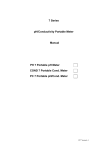
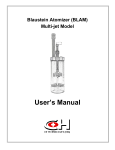
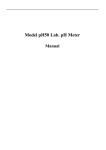
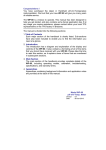
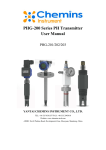
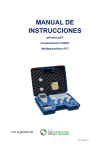
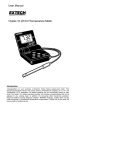
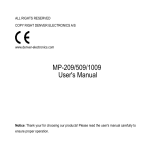

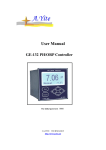
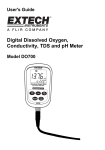
![TEMPLATE No1 [CPMP positive opinion full application]](http://vs1.manualzilla.com/store/data/005681628_1-1a3acb54fcca990dd8c826546eb4788f-150x150.png)

